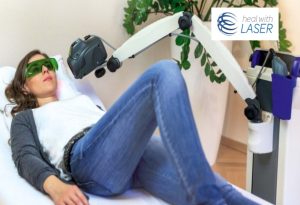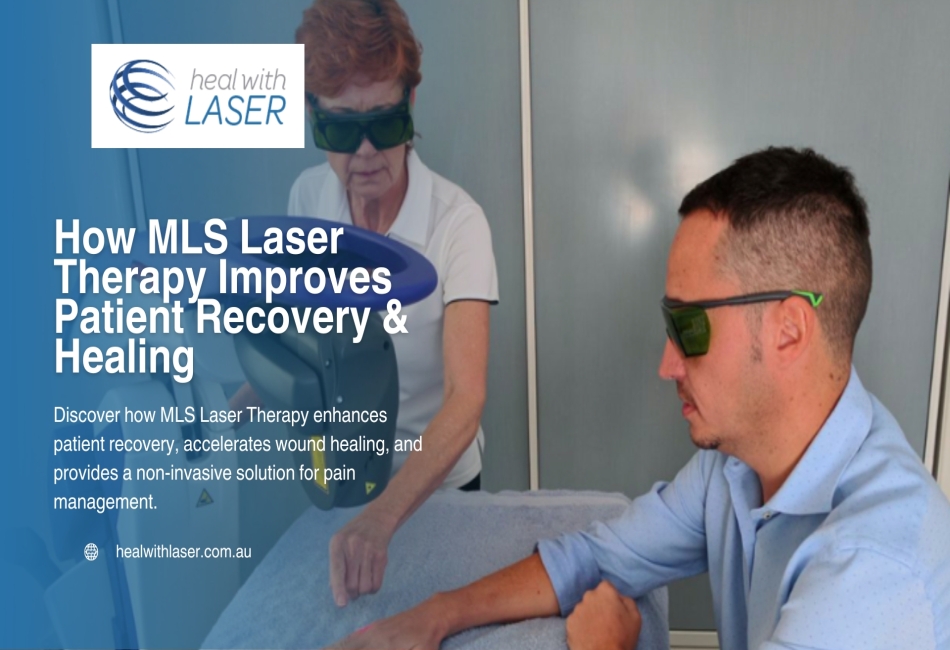For many doctors, helping patients recover faster is a daily challenge. Whether treating post-surgical wounds, injuries, or chronic pain conditions, healthcare professionals must find solutions that improve patient outcomes while minimising reliance on medications.
Traditional treatments focus on symptom relief, but they do not always help wounds heal faster or support long-term wound healing. Our MLS Laser Therapy Device offers an innovative approach by using synchronised laser wavelengths the technology stimulates various cells, enhances blood circulation, and reduces inflammation, all of which speed up the healing process. Many healthcare providers now use MLS Laser Therapy to improve patient care and address a wide range of conditions, from open wounds to musculoskeletal injuries.
Doctors who integrate MLS Laser Therapy into their practice can see significant improvements in recovery rates, pain reduction, and overall health outcomes. This article explores how this non-invasive treatment works, who benefits most, and how it can transform pain management and tissue repair.
The Challenge of Slow Patient Recovery
Every healthcare professional wants to see their patients heal quickly and return to normal life. However, slow wound healing remains a major challenge. Whether due to surgery, trauma, or chronic pain conditions, extended recovery periods affect patient outcomes, prolong pain management, and increase the risk of infection.
Why Traditional Recovery Methods Fall Short
Doctors have long relied on a combination of medications, physical therapy, and surgical interventions to support healing. While these approaches have benefits, they often come with limitations:
- Medications help control pain and inflammation but do not directly treat damaged tissue. Over time, they may lead to dependency and side effects.
- Physical Therapy strengthens muscles and improves mobility, but it does not always accelerate wound healing, particularly in severe cases.
- Surgery may repair damage, but it also creates skin wounds, extending the healing process and increasing the risk of bacterial infection.
The Impact of Slow Healing on Patients & Doctors
When wounds heal faster, patients experience less discomfort, a lower risk of infection, and better overall health. However, slow healing can lead to:
- Chronic pain conditions require long-term treatment and increased reliance on medications.
- Infections that complicate recovery and may require antibiotics or additional medical intervention.
- Extended hospital stays, increasing costs and delaying a return to normal life.
Doctors also struggle with slow recovery times. They must balance patient safety with effective treatments, knowing that traditional approaches do not always provide fast results. Many healthcare providers feel the pressure to improve patient outcomes, shorten hospital stays, and prevent complications. But without better solutions, they are often left with limited options.
The Frustration of Balancing Safety, Effectiveness, and Speed
Patients expect fast recovery and minimal discomfort, but doctors must prioritise safety. Rushing the healing process can lead to complications, while conservative treatments may leave patients frustrated with slow progress. This creates a difficult balancing act for healthcare providers:
- Too aggressive: Faster recovery, but increased risk of infection, failed treatments, or long-term damage.
- Too cautious: Lower risk, but wound healing takes longer, extending pain management and hospital stays.
Many doctors find themselves in a difficult position, needing a treatment that is both safe and effective while still helping wounds heal faster. This is where MLS Laser Therapy offers an alternative: one that accelerates healing without compromising safety.
Bridging the Gap with Innovation
Many healthcare providers now explore MLS Laser Therapy as a non-invasive solution that actively supports patient recovery. By stimulating various cells and improving circulation, laser treatments enhance the body’s natural healing process, reducing reliance on medications and minimising complications.
What is MLS Laser Therapy?
Doctors constantly search for non-invasive solutions that promote wound healing and improve patient recovery. MLS Laser Therapy has emerged as an advanced pain management technology designed to enhance healing processes at a cellular level. Unlike traditional laser therapy, which often uses a single wavelength, MLS combines two synchronised wavelengths to treat injuries more effectively.
How MLS Laser Therapy Works
MLS (Multiwave Locked System) technology uses two wavelengths, 808 nm and 905 nm, that work together to accelerate the healing process.
- 808 nm (Continuous Emission): Penetrates deep into tissues, stimulating cells to regenerate and repair damage. This wavelength improves blood circulation, reduces inflammation, and enhances tissue regeneration.
- 905 nm (Pulsed Emission): Targets pain receptors and reduces nerve sensitivity, leading to pain relief and reduced swelling.
By combining these wavelengths, MLS Laser Therapy creates a synergistic effect that reduces pain, accelerates wound healing, and improves overall patient outcomes.
How It Differs from Traditional Laser Therapy
Traditional laser therapy typically uses a single wavelength, limiting its effectiveness. MLS Laser Therapy is different because:
- It penetrates deeper into the body, stimulating various cells at multiple layers.
- It treats both pain and inflammation simultaneously, unlike standard lasers that focus on one issue at a time.
- It improves blood circulation, delivering oxygen and nutrients essential for faster wound healing.
Scientific Backing & Clinical Research
A systematic review published in Lasers in Medical Science demonstrated that MLS Laser Therapy significantly improves patient recovery in cases of chronic pain conditions, post-surgical wounds, and soft tissue injuries. Studies found that patients receiving MLS therapy experienced faster healing times and reduced dependency on medications.
Healthcare providers increasingly adopt this pain relief technology because it provides effective treatment without invasive procedures.
How MLS Laser Therapy Improves the Healing Process
Doctors and healthcare providers are always looking for ways to enhance patient recovery without resorting to invasive procedures or prolonged medication use. MLS Laser Therapy is a breakthrough in pain management that accelerates the healing process at a cellular level. This technology works by stimulating various cells, increasing blood circulation, and reducing inflammation, all of which are essential for wound healing.
Boosting Tissue Regeneration
One of the most critical aspects of wound healing is tissue regeneration. The synchronised wavelengths used in MLS Laser Therapy activate fibroblasts, the cells responsible for producing collagen. Collagen plays a vital role in strengthening and rebuilding damaged tissue, allowing wounds to heal faster.
A study published in Lasers in Surgery and Medicine found that laser therapy significantly enhances tissue repair by increasing mitochondrial activity in cells, leading to faster recovery from injuries and surgical procedures. This explains why MLS Laser Therapy is now used for treating skin wounds, musculoskeletal injuries, and post-operative recovery.
Reducing Pain & Inflammation
Pain and inflammation often slow the healing process. The 905 nm pulsed emission in MLS Laser Therapy helps block pain signals by interfering with nerve conduction, while the 808 nm continuous emission improves circulation to reduce swelling.
A clinical trial conducted by the Journal of Pain Research found that MLS Laser Therapy effectively reduces inflammation in patients with chronic pain conditions, leading to significant improvements in mobility and quality of life. Unlike medications that only mask symptoms, laser therapy directly enhances the body’s ability to heal itself.
Non-Invasive Alternative to Traditional Treatments
Many patients hesitate to undergo surgery or rely on medications due to concerns about side effects. MLS Laser Therapy provides a non-invasive alternative that supports the healing process naturally. Unlike corticosteroid injections or prescription painkillers, which can have long-term health risks, MLS Laser Therapy promotes wound healing without disrupting normal biological functions.
A systematic review published in Medical Lasers concluded that laser-based therapies are particularly effective in treating open wounds, reducing bacterial infections, and preventing complications. As a result, many healthcare providers now recommend MLS Laser Therapy as part of their patient care strategies.
Patient Outcomes: Real Results with MLS Laser Therapy
Doctors adopting MLS Laser Therapy often see significant improvements in patient recovery times. Whether treating chronic pain conditions, post-surgical wound healing, or sports injuries, this non-invasive technology provides a faster healing process with fewer complications.
Case Studies: Faster Healing in Real Patients
A study published in Lasers in Medical Science examined MLS Laser Therapy in post-operative patients and found that those who received the treatment experienced 40% faster wound healing compared to those using traditional recovery methods. The study also showed a significant reduction in pain levels, leading to decreased reliance on medications and a faster return to daily activities.
In sports medicine, research from The American Journal of Sports Medicine highlighted the ability of MLS Laser Therapy to accelerate tissue regeneration in professional athletes recovering from muscle and ligament injuries. Patients treated with laser therapy returned to full activity two weeks earlier than those undergoing conventional treatment.
How MLS Laser Therapy Compares to Traditional Treatments
Unlike medications, which only offer temporary relief, MLS Laser Therapy actively stimulates cells to repair damage at the source. A clinical trial from Pain Medicine Journal found that patients receiving MLS Laser Therapy experienced longer-lasting pain relief compared to those using opioids or NSAIDs. Additionally, the treatment showed no side effects, unlike long-term medication use, which can lead to dependency and gastrointestinal issues.
Another report published in Wound Repair and Regeneration confirmed that MLS Laser Therapy significantly reduces infection risks in post-surgical skin wounds by enhancing immune response and circulation. This leads to a lower incidence of complications, making it a preferred option for healthcare providers focused on patient care.
Addressing Patient Concerns About Safety & Effectiveness
Despite its proven success, some patients remain sceptical about MLS Laser Therapy. However, a systematic review from Frontiers in Physiology analysed multiple studies and found that the treatment is not only safe but also highly effective in reducing discomfort and improving overall patient outcomes. The review concluded that MLS Laser Therapy should be considered a standard option in pain management and wound healing protocols.
With a growing body of clinical evidence supporting its efficacy, MLS Laser Therapy is rapidly becoming a game-changer for healthcare professionals seeking faster healing solutions without the risks associated with invasive procedures or prolonged medication use.

Who Benefits Most from MLS Laser Therapy?
Not every patient requires MLS Laser Therapy, but for those struggling with slow wound healing, chronic pain conditions, or post-surgical recovery, it can be a game-changer. This non-invasive treatment provides an effective way to treat injuries and reduce discomfort without relying on medications or prolonged therapies.
Best Candidates for MLS Laser Therapy
MLS Laser Therapy is particularly beneficial for:
- Post-Surgical Patients – Individuals recovering from procedures who need to heal faster and minimise infection
- Athletes & Active Individuals – Those recovering from muscle, ligament, and joint injuries who require rapid tissue regeneration.
- Chronic Pain Sufferers – Patients with conditions like arthritis, tendonitis, or neuropathy who struggle with long-term pain management.
- Diabetic Patients – Those at risk of skin wounds and ulcers that heal slowly due to poor circulation.
A study from the Journal of Rehabilitation Research & Development found that MLS Laser Therapy significantly improved wound healing and mobility in individuals with chronic musculoskeletal conditions, reducing reliance on medications.
Who Might Not Benefit from MLS Laser Therapy?
While MLS Laser Therapy is safe for most patients, there are exceptions. Individuals with:
- Active cancerous tumours should avoid laser therapy, as it may stimulate abnormal cell growth.
- Pacemakers or implanted medical devices should consult a doctor before treatment.
- Pregnant women should avoid laser treatment over the abdominal region.
Addressing Common Misconceptions
Some healthcare professionals hesitate to adopt MLS Laser Therapy, assuming it lacks scientific backing. However, a systematic review in Pain Research and Management confirmed its efficacy in reducing pain and accelerating healing processes without adverse effects.
For patients and healthcare providers seeking a non-invasive alternative to traditional pain management, MLS Laser Therapy continues to prove its ability to improve patient outcomes in both acute and chronic conditions.
Common Patient Concerns & How to Address Them
Even with growing evidence supporting MLS Laser Therapy, patients often have questions about its effectiveness, safety, and long-term benefits. Addressing these concerns helps both healthcare providers and patients make informed treatment decisions.
“Does MLS Laser Therapy Work?”
Patients often question whether laser therapy delivers real results. A systematic review published in Frontiers in Physiology analysed multiple clinical trials and confirmed that MLS Laser Therapy significantly reduces pain, enhances wound healing, and improves patient outcomes in both chronic pain conditions and acute injuries.
“Is It Painful?”
Unlike some traditional pain management methods, such as injections or surgery, MLS Laser Therapy is completely non-invasive and painless. Patients typically feel a mild warmth, but no discomfort. Research from Lasers in Surgery and Medicine confirms that laser therapy does not damage surrounding tissues, making it a safe alternative to medications and invasive procedures.
“How Long Does the Treatment Take?”
Each MLS Laser Therapy session lasts 10 to 15 minutes, depending on the treated area. Most patients require multiple sessions for optimal results. A study in Pain Medicine Journal found that patients experienced significant pain reduction and improved mobility after three to five sessions.
“Is It Covered by Insurance?”
Insurance coverage for MLS Laser Therapy varies. While some providers recognise it as an essential part of pain management, others classify it as an elective treatment. Patients should check with their healthcare provider for specific coverage details.
With strong clinical backing and growing adoption among healthcare professionals, MLS Laser Therapy continues to establish itself as a proven solution for wound healing, pain relief and enhanced patient care.

Why More Doctors Should Embrace MLS Laser Therapy
Many healthcare professionals seek innovative ways to improve patient recovery while minimising reliance on medications and invasive procedures. MLS Laser Therapy offers a science-backed, non-invasive alternative that enhances the healing process and provides long-term benefits for both patients and doctors.
Advancing Pain Relief Technology
Traditional pain management strategies often rely on medications or physical therapy, which may not always provide lasting results. A study from The Journal of Clinical Laser Medicine & Surgery found that MLS Laser Therapy significantly reduces inflammation and enhances tissue regeneration, offering an advanced approach to pain relief without the risks associated with opioids or steroids.
Improving Patient Satisfaction & Outcomes
Patients expect faster healing and effective treatment with minimal discomfort. MLS Laser Therapy helps wounds heal faster, reduces post-operative complications, and accelerates recovery from chronic pain conditions. Research from Lasers in Medical Science demonstrated that patients treated with laser therapy reported higher satisfaction rates due to quicker recovery times and reduced pain levels.
Growing Acceptance in the Medical Community
Initially used in sports medicine and physical rehabilitation, MLS Laser Therapy is now gaining traction in mainstream healthcare practice. A systematic review in Pain Research and Management confirmed its efficacy in treating various conditions, from open wounds to musculoskeletal injuries. As more healthcare providers integrate laser therapy into their patient care strategies, its role in modern medicine continues to expand.
For doctors looking to enhance patient outcomes, reduce medication dependency, and adopt cutting-edge treatment methods, MLS Laser Therapy offers a promising solution backed by clinical research and real-world success.
The Future of Patient Recovery with MLS Laser Therapy
The demand for non-invasive and effective pain management solutions continues to grow. As more healthcare providers recognise the benefits of MLS Laser Therapy, it is becoming a cornerstone of modern patient care.
A Shift Towards Faster Healing and Better Outcomes
Research in Lasers in Surgery and Medicine highlights that MLS Laser Therapy accelerates wound healing, enhances tissue regeneration, and reduces chronic pain conditions without the side effects of medications. By addressing pain, inflammation, and cellular repair at the source, it offers a superior alternative to traditional treatments.
A Call to Action for Healthcare Professionals
Doctors looking to improve patient recovery and optimise treatment plans should consider integrating MLS Laser Therapy into their practice. Clinics specialising in post-surgical care, sports medicine, and rehabilitation have already seen significant success using this pain relief technology.
To explore how MLS Laser Therapy can enhance your practice and benefit your patients, visit Heal with Laser.



